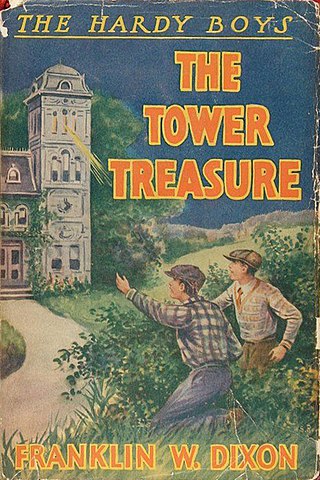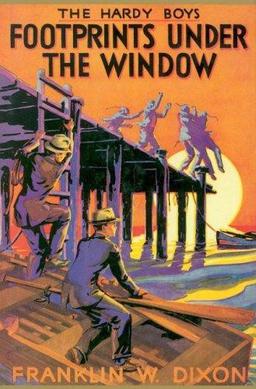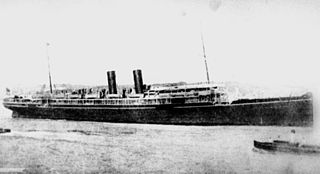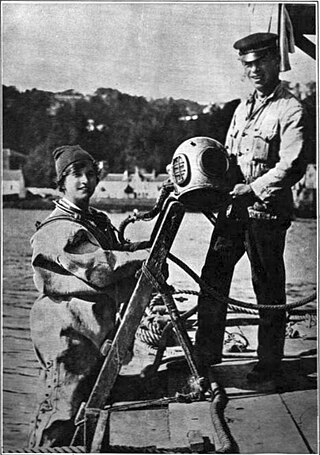
Wreck diving is recreational diving where the wreckage of ships, aircraft and other artificial structures are explored. Although most wreck dive sites are at shipwrecks, there is an increasing trend to scuttle retired ships to create artificial reef sites. Diving to crashed aircraft can also be considered wreck diving. The recreation of wreck diving makes no distinction as to how the vessel ended up on the bottom.
Charles Leslie McFarlane was a Canadian journalist, novelist, screenwriter, and filmmaker, who is most famous for ghostwriting many of the early books in the very successful Hardy Boys series, using the pseudonym Franklin W. Dixon.

The Tower Treasure is the first volume in the original The Hardy Boys Mystery Stories published by Grosset & Dunlap. The book ranks 55th on Publishers Weekly's All-Time Bestselling Children's Book List for the United States, with 2,209,774 copies sold as of 2001. This book is one of the "Original 10", generally considered by historians and critics of children's literature to be the best examples of all the Hardy Boys, and Stratemeyer Syndicate, writing.

The Mystery Of Cabin Island is Volume 8 in the original The Hardy Boys Mystery Stories published by Grosset & Dunlap. This book was written for the Stratemeyer Syndicate by Leslie McFarlane in 1929. Between 1959 and 1973 the first 38 volumes of this series were systematically revised as part of a project directed by Harriet Adams, Edward Stratemeyer's daughter. The original version of this book was rewritten in 1966 by Anne Shultes resulting in two different stories with the same title.

Footprints Under the Window is Volume 12 in the original The Hardy Boys Mystery Stories published by Grosset & Dunlap.

The Hidden Harbor Mystery is Volume 14 in the original The Hardy Boys Mystery Stories published by Grosset & Dunlap.

A Figure in Hiding is Volume 16 in the original The Hardy Boys Mystery Stories published by Grosset & Dunlap.

The Mystery of the Chinese Junk is Volume 39 in the original The Hardy Boys Mystery Stories published by Grosset & Dunlap.

A United States Navy diver refers to a service personnel that may be a restricted fleet line officer, civil engineer corps (CEC) officer, Medical Corps officer, or an enlisted who is qualified in underwater diving and salvage. Navy divers serve with fleet diving detachments and in research and development. Some of the mission areas of the Navy diver include: marine salvage, harbor clearance, underwater ship husbandry and repair, submarine rescue, saturation diving, experimental diving, underwater construction and welding, as well as serving as technical experts to the Navy SEALs, Marine Corps, and Navy EOD diving commands.

Marine salvage is the process of recovering a ship and its cargo after a shipwreck or other maritime casualty. Salvage may encompass towing, re-floating a vessel, or effecting repairs to a ship. Protecting the coastal environment from spillage of oil or other contaminants is also a high priority. Before the invention of radio, salvage services would be given to a stricken vessel by any ship that happened to be passing by. Most salvage is carried out by specialist salvage firms with dedicated crew and equipment. The legal significance of salvage is that a successful salvor is entitled to a reward, which is a proportion of the total value of the ship and its cargo. The amount of the award is determined subsequently at a "hearing on the merits" by a maritime court in accordance with Articles 13 and 14 of the International Salvage Convention of 1989. The common law concept of salvage was established by the English Admiralty Court, and is defined as "a voluntary successful service provided in order to save maritime property in danger at sea, entitling the salvor to a reward"; and this definition has been further refined by the 1989 Convention.

Treasure hunting is the physical search for treasure. For example, treasure hunters try to find sunken shipwrecks and retrieve artifacts with market value. This industry is generally fueled by the market for antiquities. The practice of treasure-hunting can be controversial, as locations such as sunken wrecks or cultural sites may be protected by national or international law concerned with property ownership, marine salvage, sovereign or state vessels, commercial diving regulations, protection of cultural heritage and trade controls.
The Antikythera wreck is a Roman-era shipwreck dating from the second quarter of the first century BC.
Keith Jessop was a British salvage diver and successful marine treasure hunter.

Everblue 2 is a scuba diving adventure game. It is the sequel to the game Everblue. Arika, the developers of both games, followed it with the spiritual sequel Endless Ocean, for the Wii.

Goldfinder is a 2001 autobiography of British diver and treasure hunter Keith Jessop. It tells the story of Jessop's life and salvaging such underwater treasures as HMS Edinburgh, one of the greatest deep sea salvage operations and most financially rewarding in history.
Salvage diving is the diving work associated with the recovery of all or part of ships, their cargoes, aircraft, and other vehicles and structures which have sunk or fallen into water. In the case of ships it may also refer to repair work done to make an abandoned or distressed but still floating vessel more suitable for towing or propulsion under its own power. The recreational/technical activity known as wreck diving is generally not considered salvage work, though some recovery of artifacts may be done by recreational divers.

Alberto Gianni was an Italian underwater diver and inventor.

SS Egypt was a P&O ocean liner. She sank after a collision with Seine on 20 May 1922 in the Celtic Sea. 252 people were rescued from the 338 passengers and crew aboard at the time. A subsequent salvage operation recovered most of the cargo of gold and silver.
Captain Guybon Chesney Castell Damant was a British royal navy officer known for his scientific research on preventing decompression illness with John Scott Haldane, his leadership over a team of divers that salvaged 44 tons of gold bullion from the wreck of HMS Laurentic between 1917 and 1924, and the covert work he and his divers performed by entering into sunken U-boats during World War I and recovering code books, ciphers, and other materials for the Naval Intelligence Division of the Royal Navy.

Anne Margaret Mary Therese Naylor more commonly known as Margaret Naylor was the first woman deep-sea diver.















